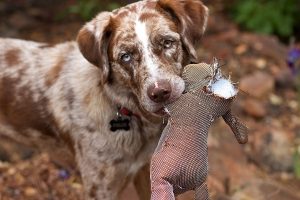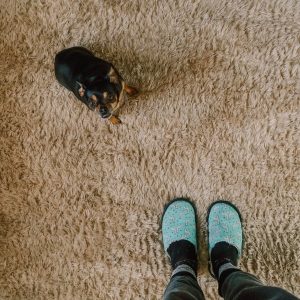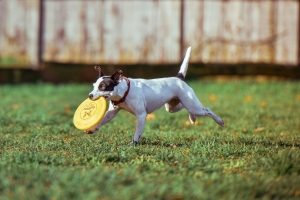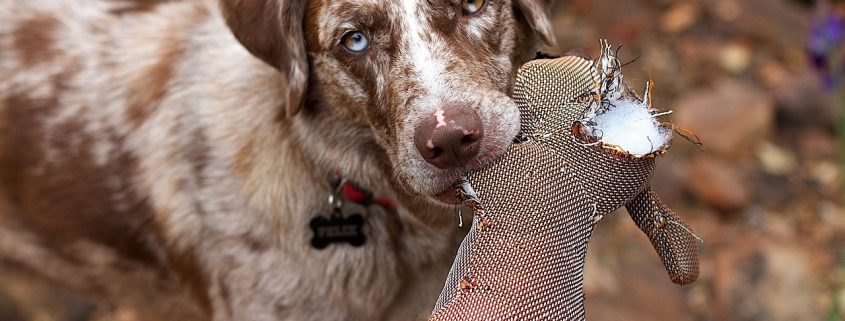Ask Crystal: Going from Destructive to Constructive
Welcome to “Ask Crystal,” where you can ask your pet behavior questions! You can submit your question for Crystal at the bottom of the page!

Dear Crystal,
We recently adopted a terrier mix puppy a couple month ago. She is about 6 months old. She recently started leaving the yard that she usually stays in. She is also very destructive in the backyard when we leave her out there with our other dog for a few hours every day. I don’t understand what is wrong with her! She is outside for a while, and she has another dog to play with, why does she still have so much energy? Please help!
Sincerely,
Destructive Dog
Dear Destructive,
Destructive behavior is one of the most frustrating of normal dog behaviors and very common especially in young untrained dogs. There are a variety of reasons why dogs can be destructive. These include boredom, excess energy, teething, stress and anxiety. In order to change the behavior, we need to examine the cause of the behavior first.
Excess energy and boredom is the largest cause of destructive behavior. Sometimes we feel that we are giving the dog enough exercise and they still are having problems. They might need more than you are providing or they may also need other forms of enrichment to keep them mentally stimulated.
Teething is a big cause of destructive behavior in young dogs. Chewing soothes the painful gums associated with teething. Puppies also explore the world with their mouths so it’s pretty natural for them to put their mouths on things. They aren’t born knowing what is ok and what isn’t to chew on. Dogs that were not well managed during their formative years of 1-2 years will often chew on inappropriate items the same way a puppy would.
In addition, stress is also a cause of destructive behavior. Chewing relieves stress and anxiety. It’s a way for them to let off some steam. If you notice your dog only chews when left alone or other times of stress or if they are showing stress signals, this could be part of the issue. Make a plan to reduce your dog’s exposure to their stressors.
Owners often attribute destructive behavior to the dog being vindictive and point to the fact that the dog appears guilty when scolded. First, understand the “guilty” look people refer to is what we call an appeasement gesture. This is a behavior meant to convey that the dog is not a threat to avoid injury. The dog sees your angry face, hears your tone of voice or remembers past experiences where you are angry when you come in the room and behaves in this manner as self-preservation.
 It is important that we control our emotions. Take a breath and calm down. It’s not going to get any worse if you take a minute to calm yourself. Yes, I know how upsetting it is to come home to a chewed-up house. Before I knew any better, I once left my year-old dog out of her crate for several hours to see how she would do. I came home to a huge pile of everything she had chewed up and I know now to experiment with very short periods of alone time to see how they do and gradually increase the time left out.
It is important that we control our emotions. Take a breath and calm down. It’s not going to get any worse if you take a minute to calm yourself. Yes, I know how upsetting it is to come home to a chewed-up house. Before I knew any better, I once left my year-old dog out of her crate for several hours to see how she would do. I came home to a huge pile of everything she had chewed up and I know now to experiment with very short periods of alone time to see how they do and gradually increase the time left out.
As always. the first step to correcting a behavior problem is to manage the dog’s behavior by managing their environment and access to it. This means unfortunately, she cannot be left alone unsupervised outside or inside. Dogs that are still in the destructive stage need to be confined in a crate or puppy proof area when not being watched. If you aren’t watching, then you can’t interrupt the behavior you don’t like and redirect it.
When your puppy is chewing something inappropriate, interrupt the behavior with a positive interrupter. This is a word or sound that you condition the dog to mean she should come over to you. When she comes over, you give her something appropriate to chew and you have gotten her away from the forbidden object. I like this better than yelling “no” at the dog because it is positive and gives the dog something to do. It’s much easier to teach the dog what to do rather than what not to do.
An important piece of the puzzle is providing lots of appropriate chew items. You will have to do some experimenting with what your dog prefers. A lot of people will purchase hard rubber toys because they seem durable. Although some dogs do like these, if they don’t, consider toys that the dog has to work to get food out of such as bones or Kongs. Many dogs that are not interested in normal toys like toys that have food in them. Find your dog’s preferences and then rotate the toys to keep them from being bored.
Puppies and high energy dogs should really be fed using food enrichment toys and/or using their dinner to train. A bowl is a wasted opportunity to train or enrich your dog’s life. Consider freezing her meals in kongs or bones to soothe her gums and give her opportunities to chew. Feeding with enrichment is a great way to tire your dog out with little effort on your part.
One of the best ways that we can prevent destructive behavior is through structured exercise. Structured exercise refers to exercise that you participate in with your dog. I hear on a daily basis that a dog just needs a big backyard to solve all their problems. What they need more importantly than a yard is a human to exercise with them. Dogs left alone in a yard will find ways to entertain themselves but as you have learned, it is not usually in a way that we would like. Usually, the entertainment is in the form of barking, digging, destructiveness and escaping.
 You don’t have to have a big yard or a fence to exercise your dog although it certainly helps. Inside the house you can play tug or an indoor fetch game. Flirt poles are an amazing invention for dogs that like to chase things. It is basically a cat teaser for dogs. Dog friendly dogs may enjoy an afternoon at dog daycare to tire them out. Or maybe your pup likes to swim or hike. Decompression walks are a fantastic way to tire a dog out and very relaxing. These are walks where you have the dog on a long line to explore a quiet area as they choose and let them sniff as much as they would like. Sniffing is a great way for a dog to relax and burns a lot more energy than a neighborhood walk would.
You don’t have to have a big yard or a fence to exercise your dog although it certainly helps. Inside the house you can play tug or an indoor fetch game. Flirt poles are an amazing invention for dogs that like to chase things. It is basically a cat teaser for dogs. Dog friendly dogs may enjoy an afternoon at dog daycare to tire them out. Or maybe your pup likes to swim or hike. Decompression walks are a fantastic way to tire a dog out and very relaxing. These are walks where you have the dog on a long line to explore a quiet area as they choose and let them sniff as much as they would like. Sniffing is a great way for a dog to relax and burns a lot more energy than a neighborhood walk would.
Nose work games are another great way to tire a dog out. Teach your dog Find it and then start hiding treats around the house. Have them in a stay and then release them to find them. Or hide treats in boxes that they have to search. Scatter your dog’s kibble in the grass for them to search for it. This game can take up quite a lot of time if the dog is really persistent.
Training is also a great way to burn energy and mentally stimulate your dog besides the additional benefit of being able to communicate with your dog and reinforce desirable behaviors. The type of training that you want to focus on for a hyper active dog will be a combination of relaxation exercises, Impulse control training in addition to recalls and leash work. Hide and go seek is a great recall game and your dog runs around the house. I also like tossing a piece of kibble away from me so the dog will chase it and then toss another when they come back to you.
As far as the dog running off, that seems pretty normal especially if she is bored or not exercised enough. The exercise will help but I really don’t expect a dog not to leave a yard. Of course, there are dogs that don’t but they are usually older and well trained.
You should also work a lot on a really reliable recall. That will help for the times when you see her run off. My number one tip for a dog that has gotten out, drop to the ground and squeal and flail your arms. Most dogs see a person on the ground and immediately run over. I have done this the few times my dogs slipped out an open gate and they all come right back. You do not want to chase a dog. You may scare it and make the situation worse. Or it may become a fun game to be chased for the dog.
The other part of the puzzle is the bond. A dog that has a really great bond with her human is less likely to want to escape. You create a bond by all the social interactions of play, training, petting, time and using happy positive training methods.
No behavior problem goes away overnight. Some behavior issues with see with puppies will improve with time provided that we manage the dog closely as it grows and teach it appropriate behaviors. Experiment with different combinations of exercise and enrichment until you find what works for your dog. Good luck!
Until next time,
Crystal







